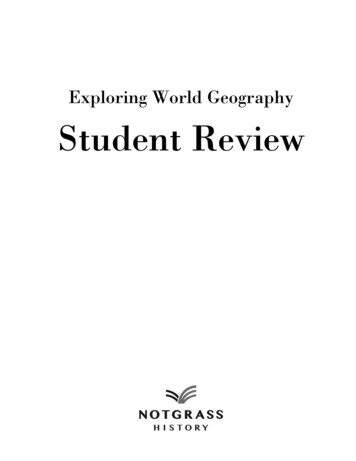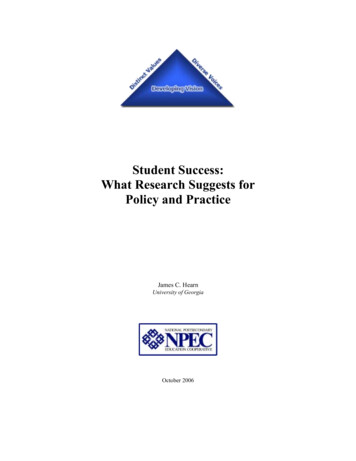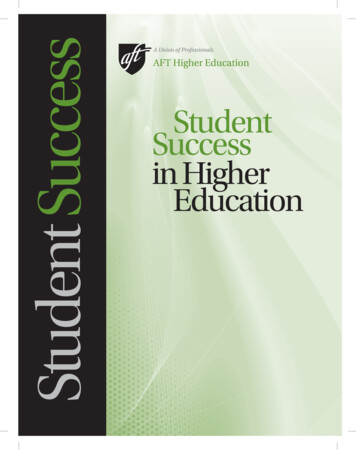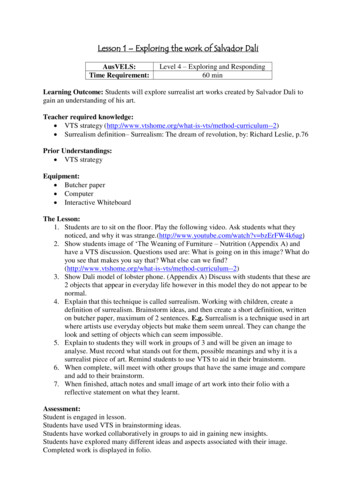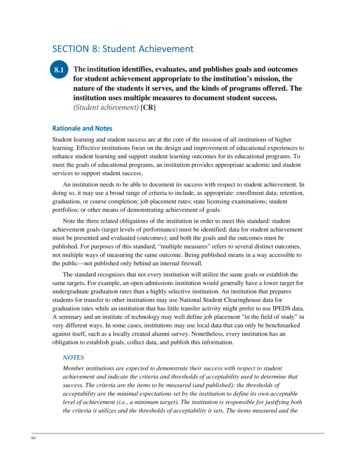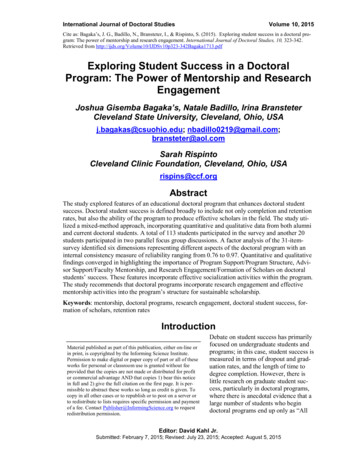
Transcription
International Journal of Doctoral StudiesVolume 10, 2015Cite as: Bagaka’s, J. G., Badillo, N., Bransteter, I., & Rispinto, S. (2015). Exploring student success in a doctoral program: The power of mentorship and research engagement. International Journal of Doctoral Studies, 10, 323-342.Retrieved from .pdfExploring Student Success in a DoctoralProgram: The Power of Mentorship and ResearchEngagementJoshua Gisemba Bagaka’s, Natale Badillo, Irina BransteterCleveland State University, Cleveland, Ohio, USAj.bagakas@csuohio.edu; nbadillo0219@gmail.com;bransteter@aol.comSarah RispintoCleveland Clinic Foundation, Cleveland, Ohio, USArispins@ccf.orgAbstractThe study explored features of an educational doctoral program that enhances doctoral studentsuccess. Doctoral student success is defined broadly to include not only completion and retentionrates, but also the ability of the program to produce effective scholars in the field. The study utilized a mixed-method approach, incorporating quantitative and qualitative data from both alumniand current doctoral students. A total of 113 students participated in the survey and another 20students participated in two parallel focus group discussions. A factor analysis of the 31-itemsurvey identified six dimensions representing different aspects of the doctoral program with aninternal consistency measure of reliability ranging from 0.76 to 0.97. Quantitative and qualitativefindings converged in highlighting the importance of Program Support/Program Structure, Advisor Support/Faculty Mentorship, and Research Engagement/Formation of Scholars on doctoralstudents’ success. These features incorporate effective socialization activities within the program.The study recommends that doctoral programs incorporate research engagement and effectivementorship activities into the program’s structure for sustainable scholarship.Keywords: mentorship, doctoral programs, research engagement, doctoral student success, formation of scholars, retention ratesIntroductionMaterial published as part of this publication, either on-line orin print, is copyrighted by the Informing Science Institute.Permission to make digital or paper copy of part or all of theseworks for personal or classroom use is granted without feeprovided that the copies are not made or distributed for profitor commercial advantage AND that copies 1) bear this noticein full and 2) give the full citation on the first page. It is permissible to abstract these works so long as credit is given. Tocopy in all other cases or to republish or to post on a server orto redistribute to lists requires specific permission and paymentof a fee. Contact Publisher@InformingScience.org to requestredistribution permission.Debate on student success has primarilyfocused on undergraduate students andprograms; in this case, student success ismeasured in terms of dropout and graduation rates, and the length of time todegree completion. However, there islittle research on graduate student success, particularly in doctoral programs,where there is anecdotal evidence that alarge number of students who begindoctoral programs end up only as “AllEditor: David Kahl Jr.Submitted: February 7, 2015; Revised: July 23, 2015; Accepted: August 5, 2015
Exploring Student Success in a Doctoral ProgramBut Dissertation” (ABD). For instance, The Chronicle of Higher Education indicated there is aneed for push for ABD’s to ‘cross the finish line’ (Leatherman, 2000). Studies on student successin doctoral programs will need to begin by defining success in the context of doctoral programs.For example, Walker, Golde, Jones, Conklin Bueschel, and Hutchings (2008) discussed the issueof the formation of scholars as a measure of program effectiveness.Doctoral students’ success may then be seen in two ways. First is the quantitative one that ensuresthat students do not remain as ABD. When a large proportion of doctoral students end up asABD, it denies academic fields sufficient scholars with terminal degrees. Second is the qualitativeone that emphasizes the formation of scholars. Pushing the ABD doctoral students to cross thefinish line is necessary but not sufficient without producing scholars who are sufficiently grounded in the content and research in the field. Successful doctoral programs may then be defined asthose that will produce effective scholars in the field as well as providing mechanisms and resources that will reduce attrition rates. The question, then, pertains to the identification of program features, as well as program practices, that promote the formation of scholars which increases the chances of students’ completion rates. It is important to identify programs that incorporate aspects such as successful program mentorships and doctoral student engagement in research as part of their program activities.It is estimated that approximately 50% of entering doctoral students fail to obtain their degree(D’Andrea, 2002; Johnson, Green, & Kluever, 2000). These numbers are closely related to undergraduate students’ completion rates (Berkner, He, & Cataldi, 2002). The Chronicle’s onlineacademic discussion forum held on January 15, 2004 (“Why Do Graduate Students Drop Out?”2004) addressed the question of why doctoral students drop out of the program. Though the forum generally acknowledged the lack of data on the subject, views of participants varied widely.One point of convergence among discussants was the fact that doctoral students, unlike duringtheir prior years of schooling, work in an environment that is unstructured, requiring a great dealof independence. Without proper guidance and mentoring, such an environment can be disorienting for some students. Contact and interaction between students with peers and faculty membershave been shown to be a factor in doctoral student completion rates (Pascarella & Terenzini,1977; Terenzini & Pascarella, 1977). However, this contact need not just be with classroom oradvising activities, but ought to go beyond that (Nagda, Gregerman, Jonides, von Hippel, & Lerner, 1998; Pascarella & Terenzini, 1977). For instance, Cockrell and Shelley (2011) revealed apositive relationship between doctoral students’ satisfaction and the relationship with their advisor. Mason (2012) seemed to validate these findings but, in addition, found a positive relationshipbetween students’ feelings of autonomy over their research and their motivation to continue graduate school, highlighting the importance of mentorship while providing mentees academic spaceto form their own research identity.Gardner (2008) argued that a “lack of socialization” in doctoral programs increases the risk fordoctoral student attrition. The less a student fits the “expected” socialization pattern, the morelikely a student is at risk of not finishing the doctoral program; this is especially true for studentsfrom underrepresented populations (women and students of color). Gildersleeve, Croom, andVasquez (2011) stated that it is not uncommon for underrepresented students to experience “racialized aggressions” (p. 110), which may heavily impact students’ emotional states. Ali and Kohun (2006) discussed students’ feelings of isolation at four program stages of the Ph.D. studyprocess including the following: a) preadmission to enrollment, b) the first program year, c) thesecond year until candidacy, and d) the dissertation stage. According to the authors, each programstage has its own unique stressors that can contribute to isolation. They stated, “confusion aboutprogram requirements can quickly turn into feelings of [being] overwhelm[ed] and being ‘leftbehind’” (Ali & Kohun, 2006, p. 24).324
Bagaka’s, Badillo, Bransteter, & RispintoGardner (2008) concluded that not only did historically underrepresented students have difficultywith the socialization pattern, but so did nontraditional students (older students and/or studentswith children). Academic discipline and the educational environment of the academic institution(“institutional context”) seem to also determine the impact of socialization (the problems of oneschool or department may not be the problems of another). Gardner suggested that institutionsought to offer more support, and that students should seek to become more involved (through student organizations and departmental committees), which would in turn help students find theirplace in the socialization “mold” of doctoral study programs.According to Gildersleeve et al. (2011), faculty guidance is experienced through “socialization”,which is defined as “ the process by which doctoral students learn the customs, traditions, andvalues of any given discipline or field through mentoring and advising relationships as well as byengaging in research, service, and teaching” (p. 94). How this process is put into place—and theaspects of its focus—varies within programs and institutions. The literature has discussed thepresence of faculty-student mentorship, research engagement, and peer mentorship activities asexamples of program features that can be effective in the formation of scholars as well as in enhancing doctoral students’ completion rates.MentorshipA method of socialization utilized within graduate study programs is mentorship. In general,mentoring relationships can be either formal (as assigned by the program) or informal (naturallydeveloping between the mentor and mentee). In doctoral programs however, most academic advisors evolve into the dual role of advisor and mentor, with a majority of them providing a widerange of support, including psychosocial and career mentorship. Mentorship activities are oftenshaped by the outcome needs of the program and the training needs of the students (Ali & Kohun,2006; Harty, Kormanyos, & Enochs, 1983; Ward, Johnson, & Campbell, 2004). Mentorship involves teaching, coaching, and giving personal and professional guidance (Dobie, Smith, & Robins, 2010) usually for a fixed period of time (Hayes, 2005); for example, during the time that thestudent is working through the requirements of the graduate program (Dobie et al., 2010) or during a specific phase of the student’s training (Hayes, 2005). University programs often have aheavier reliance on research-based mentorship activities (Ward et al., 2004).Hu, Thomas, and Lance (2008) also looked at the factors that appeared to promote the formationof mentoring relationships. They hypothesized that there were three factors that were most influential in the initiation of the mentoring relationship: similarity in race, sex, or age between thementor and mentee; how the mentee views membership in his/her social group (defined by race,sex, or age), in terms of how their group has generally been treated by society; and how proactivethe person appears to be with accomplishing tasks and goals in the eyes of others (the appearanceof power, in the case of the mentor, or potential for success, in the case of the mentee).Mentoring relationships can offer benefits for both the mentor and the mentee. For the mentee,the mentor can help increase the student’s self-confidence and self-efficacy; give the student increased protection, support, and guidance during the socialization process; increase the level ofthe student’s academic and professional progress; and provide unique opportunities for professional and personal growth in the culture of the organization (Hayes, 2005; Warren, 2005; White,2007), as well as in the profession of choice (Cho, Ramanan & Feldman, 2011). For the mentor,the relationship can help with “validating the mentor’s efforts and status” (Hayes, 2005, p. 442)as the mentor observes the mentee’s growth and encourages self-efficacy in the mentee (Hayes,2005). The mentor also gains a future colleague and ally in the organization (White, 2007), aswell as assistance with his or her work and greater exposure within the organization (Warren,2005). The mentor, mentee, and organization all benefit from the student’s socialization andguidance with the workings of the specific organization or institution (Hayes, 2005). The mentor325
Exploring Student Success in a Doctoral Programis also a professional role model for the student in terms of professional involvement and behavior (White, 2007).Research EngagementAnother important feature of doctoral student success, though seldom mentioned in the literature,is the level of engagement in academic research (Nagda et al., 1998). Although studies that haveexplored this issue of student engagement primarily utilized undergraduate students, results convey compelling evidence that student engagement in academic and educational activities shouldbe considered when discussing doctoral students’ success. For example, Hughes and Pace (2003)conducted a study with college students, concluding that students who are less engaged in suchactivities leave college earlier or without completion. Similarly, a more recent study with collegestudents showed that student engagement had a significant impact on students’ persistence andgrades (Kuh, Cruce, Shoup, Kinzie, & Gonyea, 2008). More recently, Lambie, Hayes, Griffith,Limberg, and Mullen (2014) showed that doctoral students’ levels of engagement in research activities, including publishing manuscripts, have significantly higher levels of research selfefficacy, which is also related to research knowledge and productivity. Given that preparingscholars in the field is the primary goal of Ph.D. programs, it makes doctoral students’ engagement in research activities critical in the formation of scholars.Peer MentorshipReflexive conversations among graduate students and, in particular, doctoral students have revealed the extreme challenges, barriers, and hurdles of doctoral education and the pursuit of adoctoral degree: the infamous three letters doctoral students so adamantly strive to achieve – thePh.D. In the seminal work of The Formation of Scholars, Walker and colleagues (2011) revealedthe importance of moving doctoral education into the future. The challenges to doctoral educationinclude high attrition rates, lack of financial resources, mismatch between opportunities and experiences, difficulties establishing support in addition to domestic responsibilities especially fornon-traditional students. Creating opportunities and an environment that promotes scholars whoare able to be successful and productive participants in the greater academic and educational research community is a challenging task that requires unwavering dedication (Hadjioannou, Shelton, Fu, & Dhanarattigannon, 2007).A new perspective is required when approaching doctoral student challenges. A key componentin doctoral student success is the socialization process (Gardner, 2007) among peers and the support they provide each other. In addition, as Gardner (2007) points out, the majority of the extantliterature encompasses all graduate school socialization, rather than examining the socializationand peer support by degree level. The importance of researching and understanding peer supportby degree level is illustrated by Conrad, Duren, and Haworth (1998) in their work examining thedramatic differences in the structure and culture between master’s and doctoral level education.Weidman, Twale, and Stein (2001) described four developmental stages of socialization in doctoral education: anticipatory stage, formal stage, informal stage, and personal stage. Within eachof these stages, doctoral students are navigating their social experiences to foster developmentalgrowth as a scholar by gaining knowledge, skills, and values necessary for completing their degrees and advancing their careers in the field.Support is a vital factor for doctoral student retention and graduation. Although support can beoperationalized in various forms, support for the purpose of doctoral education socialization willbe viewed as peer support. In a qualitative study where Gardner (2007) conducted semistructured interviews with 20 full-time (twelve female and eight male) chemistry and history doctoral students, ranging from first-year to sixth-year study in their respective programs, a substantial proportion of these students identified peer support as a factor that plays a role in retention326
Bagaka’s, Badillo, Bransteter, & Rispintoand completion. Gardner revealed that students approached more advanced students and soughtinformation about the program and previous educational experiences they may have encountered.In addition, they sought guidance and support when determining which research groups to joinand which professors were approachable and/or most informative.Formally, peer-mentoring programs match novice students with more advanced students in theirdoctoral program to provide academic support, emotional support, and guidance as they maneuver through their own personal experiences (Brown, Davis, & McClendon, 1999; Gardner, 2008).In addition, a study conducted by Grant-Vallone and Eshner (2000), concluded that peermentoring provided additional support for students. The additional support provided by studentsmay be a necessary socializing support system set in place for overworked and overbooked faculty members, dissatisfaction with the quantity and quality of supervision or guidance received, andfeelings of isolation or frustration that will surely ensue during doctoral education and training(Hadjioannou et al., 2007).Peer mentoring may also be established informally, as students socialize more frequently andbegin to relate their frustrations, anxiety, and fears to one another on a level that family members,partners, or friends may not understand. Hadjioannou et al. (2007) created “co-travelers” whoprovided support and encouragement as they navigated the doctoral student process. This coexperience provided an avenue for students to share their worries without the fear of being evaluated by their program.Peer-mentoring encourages cohesiveness, inclusion, and support while refuting feelings of isolation that lead to failing to complete doctoral training. To examine the importance of cohort models, the University of California conducted a case study researching peer mentoring among students and faculty interactions (Dorn & Papalewis, 1997). Students were assigned an individualpeer mentor from an existing cohort and were advised to form a supportive, working relationship.This form of peer mentoring relationships is considered to be a cornerstone for the preparationand formation of scholars.Regardless of the delivery model (cohort versus non-cohort, full versus part-time, residential versus commuter, etc.), the literature identifies several features that can be effective in doctoral students’ success (program completion and formation of scholar with research skills). These featuresinclude but are not limited to faculty mentorship arrangements, research engagement, and peermentorship activities. Programs often incorporate these features into their program through a variety of ways, including providing opportunities for teaching and research assistantships, linkingstudents with faculty mentors, and promoting research partnerships between and among facultyand students. Effectively incorporating these features and practices into specific doctoral programs can be an important predictor of doctoral students’ success.Purpose of the StudyThe purpose of the study is to explore doctoral program practices and features that enhance doctoral students’ success, thus lending more information on how to make doctoral programs moreeffective. In the context of the study, program features include but are not limited to specific program requirements, organization, and human and physical resources provided to students. Specifically, the following research questions are addressed:1. To what extent does the quality of faculty-student mentorship predict the success of doctoral students?2. To what extent does student engagement in academic research predict doctoral students’satisfaction with the program?3. Does peer mentorship have any influence on student success?327
Exploring Student Success in a Doctoral Program4. What are some of the important features (requirements and resource provisions) of thedoctoral program that enhance doctoral students’ success?Significance of the StudyButz, Bloom, Gross, Kelly, Kofner, and Rippen (2003) analyzed the award of doctoral degrees insix broad fields between 1975 and 1999 and found Ph.D degree awards generally increased for 15years and then leveled off and started to fall in 1998. Though studies to analyze recent trends beyond 2000 are scarce, Butz et al. (2003) noted that the awards of Ph.D to non-citizens in Americain science, engineering, and health doctoral degrees has been increasing and may therefore account for a substantial proportion of overall degrees awarded. The number of doctoral degreesawarded to American citizens in these disciplines may be dropping.An important benefit of increasing the quantity and quality of doctoral degrees completed is thelink between research production and innovation in a society. Any nation will argue for increasing number of researchers in order to increase research output in various fields, in order to enhance development, innovation, and effective delivery of goods and services. Increasing doctoralstudents’ completion rates as well as employing program features and activities that produce effective scholars should therefore be a desirable objective of doctoral programs.Research MethodologyIntroductionThe study utilized a mixed-method approach, incorporating quantitative and qualitative data fromboth alumni and current doctoral students. A survey was used to collect primarily quantitativedata from alumni and current students. This method was considered effective in collecting datafrom participants (program alumni and current students) some of whom were geographicallywidely dispersed. In order to collect more detailed data from both current and graduate students,a qualitative methodology was also considered effective in examining the unique experiences ofthese participants while in the program. The use of qualitative data was beneficial in further understanding and validation of the quantitative findings as well as examining the role of nonquantifiable features of doctoral programs.ParticipantsParticipants for this study included current students enrolled in a traditional educational doctoralprogram at an urban university in the Midwest. In addition, alumni students who had graduatedfrom the program over a fifteen-year period were also included in this study. Students in the specializations of Leadership and Lifelong Learning, Learning and Development, Policy Studies,Counseling Psychology, and School Administration were represented in the study. Table 1 presents the number and percentage of participants by various demographic characteristics. A total of115 participated in the survey, of whom 80 (or 69.6%) were current students and 33 (or 30.4%)alumni. Seventy-three percent of the survey participants were female. Breakdown by employment and student status shows that 81 (or 70.4%) were employed full-time and 51 (or 44.3%)were full-time students, indicating that a substantial proportion of these doctoral students werefull-time in both employment and doctoral studies while pursuing their doctoral studies. Twentyseven (or 23.5%) of the participants were on graduate assistantship while pursuing their studies.In addition to the 115 survey participants and addition 20 students participated in two parallelfocus group discussions.328
Bagaka’s, Badillo, Bransteter, & RispintoTable 1: Number and percentage of survey participantsby various demographic characteristicsCharacteristicParticipant StatusGenderRaceStudent StatusEmployment StatusGraduate AssistantshipLevelsCurrent StudentAlumniMaleFemaleNo rt-timeNot 16.512.229.670.4InstrumentationThe survey monkey instrument used in the study had five sections in addition to one section ofdemographic characteristics and another on graduate assistantship experience. The five sectionswith a combined 41 items covered students’ perceived involvement and experience in groups interactions (faculty and/or other students), doctoral program support, level of research engagement, and overall satisfaction with the program experience and were rated on a four-point Likerttype scale: (1) Strongly Disagree (2) Disagree (3) Agree (4) Strongly Agree.Data Collection ProcedureOnce necessary permissions and IRB approval was granted, a survey was distributed to all alumniand current students of the program. In order to triangulate the data in the study, two focus groupswere held: one for alumni and one for current students. A series of questions were provided ineach focus group to prompt an open discussion regarding their personal experiences regardingresearch engagement, faculty mentoring, group and peer interaction, and perceived levels of support. Each of the focus group discussions were administered by individuals outside the researchteam. Notes were taken and concurrently digitally recorded for validation purpose in transcriptionof the data.Data AnalysisThe principle component factor analysis was used to identify dimensions of student experience inthe program, including research engagement, faculty mentoring, peer mentoring/interaction, program support, and the overall perception of student success. In this case, dimensions are definedas constructs that capture aspects of the program that were used as predictors of student success.These dimensions are treated as primary predictor variables of the study. Consequently, a multiple linear regression model was used to determine the extent to which these dimensions (constructs) of the program predict doctoral student success and satisfaction in the program.329
Exploring Student Success in a Doctoral ProgramThe approach to the qualitative data used the Consensual Qualitative Research model (Hill, Knox,Thompson, Nutt Williams, and Hess, 2005). This approach was employed to explore the qualitative data analysis for several reasons. The semi-structured focus groups were open-ended allowing for a more in-depth examination of individual and group experiences. The data collected wasanalyzed by three separate researchers that allowed for multiple perspectives on the overarchingdomains and codes embedded in each student experience. Once a consensus was reached regarding the domains and codes, an outside, fourth researcher audited the transcripts to ensure the quality of work (Hill et al., 2005).The mixed method approach provided researchers with a better understanding of the extent towhich variables play a role in student success, as well as, how their unique experiences impactedthe way they interacted with peers, faculty, and their overall doctoral studies environment.FindingsQuantitative FindingsA factor analysis of the 31 items from five sections of the survey identified six dimensions representing different aspects of the doctoral program. Based on the items that loaded into each ofthese factors, the following dimension were identified:1. General Quality and Structure of the Program: This dimension captured the general structure and organization of the program, including effective communicationwith program leadership. The item on the availability of courses when needed alsoloaded into this dimension.2. Group Interaction: Items that represented intra- and inter-specialization interactionwith colleagues within the program, as well as collaboration with other graduate students across the university, capture the main features of this dimension. Items in thisfactor also included those that linked these interactions with persistence in the program and fostering positive relationships with other graduate students.3. Quality of Program Support: The six items that loaded into this factor captured thequality of support students received from program staff and interactions with facultywho taught doctoral courses. Some items in this factor showed the value of promptfeedback from faculty.4. Quality of Advisor Support: The two items that defined this dimension focused onthe quality of advisor support and availability. Accessibility of the faculty advisorand willingness to spend time with the student are important aspects of this dimension.5. Research Engagement: The items that captured this dimension were related to aspects that encouraged and provided support to engage in research activities. Itemsthat captured the extent to which students are provided with opportunities to collaborate with faculty and other students in doing research loaded into this factor. Someitems in this factor assessed the value of opportunities the present at research conferences and publishing in refereed journals.6. General Satisfaction: The items that captured students’ level of satisfaction with theoverall doctoral experience, skills so far acquired, as well as quality on mentorshipreceived were represented in this dimension.Each of these six dimensions was internally consistent with the Cronbach’s Alpha reliabilityranging from 0.76 to 0.97 (see Table 2). Items that loaded into each of these factors were used tocreate composite variables representing the six dimension of the doctoral program. These dimen-330
Bagaka’s, Badillo, Bransteter, & Rispintosions represented important variables of the study along with certain participants’ demographiccharacteristics.Table 2: Cronbach’s Alpha reliability coefficients for the six dimensionsof the doctoral program# of itemsAlphaGeneral Quality of the Program60.875Group Interaction80.812Quality of Program Support60.934Quality of Advisor Support20.968Research Engagement50.770General program Satisfaction40.762DimensionThe multiple linear regression model was used to dete
Research Engagement Another important feature of doctoral student success, though seldom mentioned in the literature, is the level of engagement in academic research (Nagda et al., 1998). Although studies that have explored this issue of student engagement

